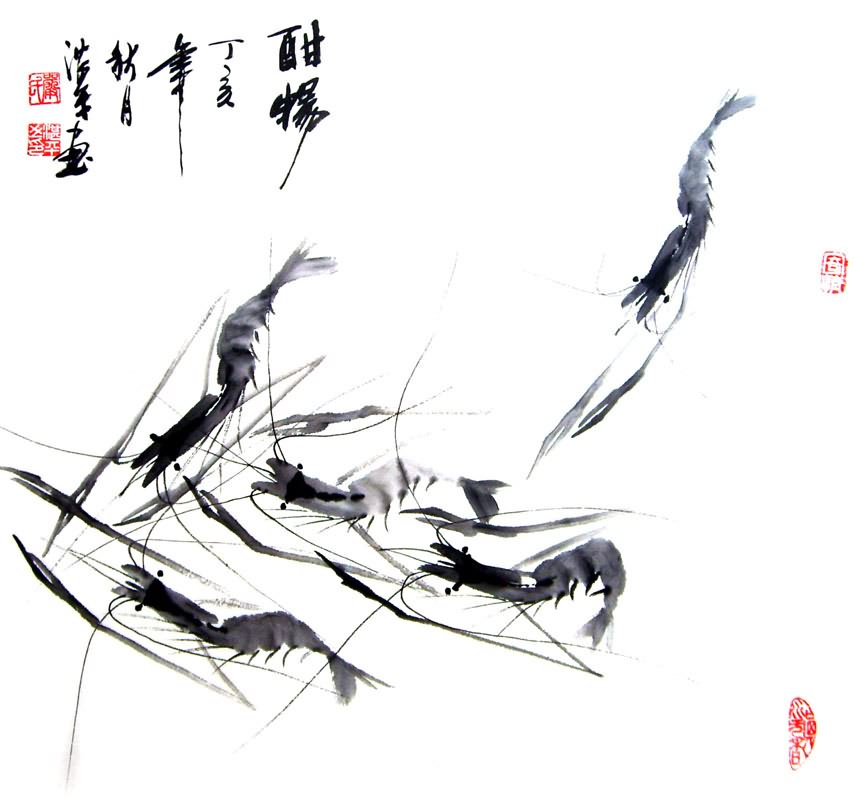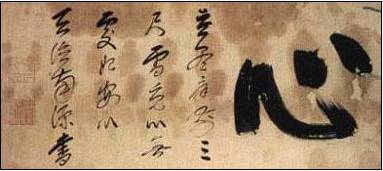"to picture the Tao in the world imagine rivers and the sea" - LaoZi, DaoDeJing, 32.5

Quantum physics shows us that we can reduce everything in existence down to patterns of flowing energy - apparently set in motion by the Big Bang, or perhaps having always been in motion. This flowing energy 'condenses' in certain places to form all the variety of phenomena we see - the stars, clouds, mountains, oceans, and ourselves. The ancient Chinese Daoists considered this massive, ungraspable system - the universe in it's entirety - the Dao.
 |
| Fragment of the Nine Dragon Scroll, China 1244 CE. |
"Layman Pang had submerged himself in the sutras and one day he found that he, too, was in over his head. He hadn't learned to swim yet. On that day, he stormed out of his monastery-hut and, in abject frustration complained to his wife, "Difficult! Difficult! Difficult! Trying to grasp so many facts is like trying to store sesame seeds in the leaves of a tree top!"
His wife retorted, "Easy! Easy! Easy! You've been studying words, but I study the grass and find the Buddha Self reflected in every drop of dew."
Now, Layman Pang's daughter, Ling Zhao, was listening to this verbal splashing, so she went swimming by. "Two old people foolishly chattering!" she called."
 |
| A traditional Chinese ink painting of shrimp. |
"We are rather like whirlpools in the river of life. In flowing forward, a river or stream may hit rocks, branches, or irregularities in the ground, causing whirlpools to spring up spontaneously here and there. Water entering one whirlpool quickly passes through and rejoins the river, eventually joining another whirlpool and moving on. Though for short periods it seems to be distinguishable as a separate event, the water in the whirlpools is just the river itself. The stability of a whirlpool is only temporary. The energy of the river of life forms living things—a human being, a cat or dog, trees and plants—then what held the whirlpool in place is itself altered, and the whirlpool is swept away, reentering the larger flow.[...] What we can best do for ourselves and for life is to keep the water in our whirlpool rushing and clear so that it is just flowing in and flowing out. When it gets all clogged up, we create troubles—mental, physical, spiritual. We serve other whirlpools best if the water that enters ours is free to rush through and move on easily and quickly to whatever else needs to be stirred. [...] By being protective and anxious, clinging to our assets, we clog up our lives. Water that should be rushing in and out, so it can serve, becomes stagnant. A whirlpool that puts up a dam around itself and shuts itself off from the river becomes stagnant and loses its vitality."
 |
| A Whirlpool Galaxy. |
Water seems insufficient to cater for all the general aspects of the universe, however, in the sense that the flowing energy of the universe can manifest as intense heat - our Sun is a perfect example of that. Heat is not a property that water is ever considered to have without having made contact with some other force or element. Our bodies, although mostly made of water, are warm-blooded, and the neurons in our brain 'fire' with electrical activity. The antagonistic elemental force which appears to heat and boil the 'waters of the Dao' is therefore fire. Together, the elements of fire and water - often referenced within Daoism as embodying yang and yin respectively - famously interact to create the dynamic universe.
Harnessing fire apparently revolutionized and fundamentally changed the way humans lived. A recent news article: Scientists find clue to human evolution's burning question (2012) states:
"Richard Wrangham, a professor of biological anthropology at Harvard University, has argued that the invention of cooking split the ancestors of humans from the evolutionary path that went on to include modern gorillas and chimpanzees. Cooking allowed our ancestors to develop bigger brains and, in his hypothesis, is the key reason modern humans emerged. The controlled use of fire, according to Wrangham, was a more important milestone in human evolution than the invention of agriculture or eating meat."Fire may not only have brought us warmth, light, cooked vegetables, and new weapons, however. Mindfulness teacher Dr Jon Kabat-Zinn, in his book Full Catastrophe Living (2005), posits, p356:
"Sitting around fires at night, their only sources of heat and light, had a way of slowing people down-it was calming as well as warming. Staring into the flames and the embers, the mind could focus on the fire, always different, yet always the same. People could watch it moment by moment and night after night, month after month, year after year, through the seasons and see time stand still in the fire. Perhaps the ritual of sitting around fires was mankind's first experience of meditation."

Fire, within us, however, has often not had such positive connotations. The 'burning' of the passions like an intense fiery hell is something everyone seems to be familiar with. Vietnamese Zen teacher Thich Nhat Hanh, in his book The Heart of Buddha's Teaching (1998), writes, p79:
"The fire of anger burns in us day and night and causes us to suffer — even more than the one at whom we are angry. When anger is absent, we feel light and free."In another of his books, Understanding Our Mind (2001), Thich Nhat Hanh talks of how it is ourselves who light these fires, p3:
"Early Buddhist texts talk about these three realms of samsaric existence as being like a “house on fire.” The three realms are burning, and it is we who light the fire through the false perceptions of our consciousness. The purpose of Buddhist practice is to transform the suffering of these realms and stages."
 |
| Siddhartha Gautama (Buddha) being attacked by the flames of Mara as he sat meditating. |
"Nirvana means pacifying, silencing, or extinguishing the fire of suffering."We must understand how this fire within us is kindled and flares up, and once we know it's nature, we are no longer perturbed by it - outside or inside, and we can avoid pouring any extra fuel on destructive habits which may be burning out of control.
It seems this peace a human being can make with the intense burning of being - some of it inescapable - can reach incredibly deep levels. This is a photograph of the Vietnamese Mahayana Buddhist monk Thích Quảng Đức burning himself alive in demonstration while meditating in1963:

Making peace with the necessary fires which blaze up in and around us requires a deep trust in nature - that everything is natural and in harmony with the universe, and that there is a positive side to any seemingly destructive event outside of our control. As Charolotte Joko Beck writes in her book Everyday Zen (1997), p110:
"Destruction is necessary. A good forest fire is necessary. The way we interfere with forest fires may not be a good thing. Without destruction, there could be no new life; and the wonder of life, the constant change, could not be. We must live and die. And this process is perfection itself."It is not only fire which is destructive of course; water can be incredibly damaging - for example in the form of a Tsunami, or even as an erosive force. Dr Kabat-Zinn, in his book Wherever You Go, There You Are (2004), writes, p142:
"We know that the water principle is every bit as elemental as rock, and that its nature is stronger than rock in the sense that water wears down rock."
 |
"you can picture life as an ocean, with the constant ups and downs you experience as the waves that churn and roil on the water’s surface. When you meditate, you dive beneath the surface to a quiet place where the water is calmer and more consistent."In the book Mindfulness for Dummies (2010), this theme is also present, p71:
"The waves aren’t bad – they’re just part of the ocean. Going further down, the waves of doing rest on the still waters of being... Being is your sense of who you are. Being is characterised as a state of acceptance, a willingness to be with whatever is. Being is tranquil, still and grounding."

The waves will never stop as they are a natural feature of our existence. Thich Nhat Hanh describes this situation in Understanding Our Mind, p147:
"five consciousnesses are based on the sixth consciousness, mind consciousness. They manifest either separately or together with mind consciousness like waves rising up from the ocean. Mind consciousness is like water and the five sense consciousnesses are like waves upon the water."This is further supported in more simple language in the book Zen Mind, Beginner's Mind (1995) by Japanese Soto Zen teacher Shunryu Syzuki, p35:
"Even though waves arise, the essence of your mind is pure; it is just like clear water with a few waves. Actually water always has waves. Waves are the practice of the water.. To speak of waves apart from water or water apart from waves is a delusion. Water and waves are one."

The essence of the practice relating to these 'ocean waves' seems to be put most clearly by Dr. Kabat-Zinn in Full Catastrophe Living, p52-53:
"In meditation the breath functions as an anchor for our attention. Tuning to it anywhere we feel it in the body allows us to drop below the surface agitations of the mind into relaxation, calmness, and stability. The agitation is still at the surface just as the waves are on the surface of the water. But we are out of the wind and protected from their buffeting action and their tension-producing effects when we shift our attention to the breath for a moment or two. This is an extremely effective way of locating a peaceful center within yourself. It enhances the overall stability of your mind."
As one practices this simple yet difficult method, one's acceptance of the necessary pains of life can increase, and transformation can take place.
Water can purify and make way for new growth, and so can fire if one skillfully harnesses these respective elements in one's practice. Water seems to have an advantage over fire for us, however, due to it's ability to be handled without bringin harm, and it's nature to accept anything within it's being. These properties of water are highlighted in a story where the Buddha's disciple Shariputra demonstrated his understanding, in Thich Nhat Hanh's The Heart of Buddha's Teachings, p200:
"[Shariputra said to the Buddha:] I have learned the lesson you offered to Rahula to practice like water. Whether someone pours a fragrant substance or an unclean substance into the water, the water receives them all equally without grasping or aversion. Water is immense and flowing and has the capacity to receive, contain, transform, and purify all these things."
Understanding these teachings as a metaphor is not enough, however, as Thich Nhat Hanh writes in The Sun My Heart (1988), we must come to truly realize and know the watery Dao which incorporates our being so that we can live consciously connected to it at all times, p133:
"Most people view themselves as waves and forget that they are also water. They are used to living in birth-and-death, and they forget about no-birth-and-no-death. A wave also lives the life of water, and we also live the life of no-birth-no-death. We only need to know that we are living the life of no-birth-nodeath. All is in the word "know." To know is to realize. Realization is mindfulness. All the work of meditation is aimed at awakening us in order to know one and only one thing: birth and death can never touch us in any way whatsoever."As we continue to practice being more water-like in our mindful lives, we can begin to see new growth appearing, as if our water has encouraged seeds of hidden joy within us to germinate and take root. Thich Nhat Hanh uses this metaphor in Understanding Our Mind, p44/42:
"Mindfulness is the water that nourishes the bodhi seed, the seed of awakening. If in our daily lives we practice mindfulness in order to look deeply at things, one day Right View will bloom like a flower permanently and not just from time to time in our mind consciousness."Transformation cannot happen in water alone, however - for that to happen we need to add something more reactive to the mix, and so next we will turn to the teachings on the positive role of the fire element in mindfulness practice .... in Part 2.
"In order to grow, mindfulness needs nourishment. We all have seeds of mindfulness, loving kindness, understanding, and joy in us. These seeds can become beautiful flowers if we can learn how to transform the garbage of our hatred, discrimination, despair, and anger."
 |
| Sunset from Ta Keo Temple - taken by the author during a visit to Angkor Wat complex, Cambodia, 2009. |


















